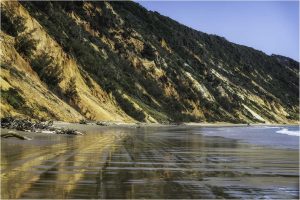Photographing Cooloola: Beach Drive to Double Island Point
By Julie Hartwig, Tin Can Bay Camera Club
This issue we look at photographing the beach drive to Double Island Point. This drive provides numerous opportunities to stop along the way to photograph the coloured sands, waves, beach activities and beach scenes. Here are some tips:
- Apart from high tide when beach access is restricted in places, there isn’t really an ideal time to photograph the area; some times of day are just better than others.
- Early morning (preferably in the hour around sunrise) is one of the best times to photograph the coloured sand cliffs as the early morning light makes the colours in the cliffs glow. It’s also a great time to photograph waves and the spray blowing off them, which is backlit by the rising sun.
- After mid-afternoon is the least favourable time as the beach and cliffs are then in shadow – this will create difficult conditions for exposure with dark shadows and bright skies (sun setting behind the cliffs in the western sky).
- Look for the details in the scenery – dead trees, texture and contours such as channels in the beach caused by water flowing down from the cliffs, and wet sand reflections.
- One of the iconic views of the drive is shooting along the beach with wet sand in the foreground and vehicles travelling along the beach.
- At Double Island Point, remember to look for wildlife such as birds and sea and beach critters. A telephoto lens comes in useful for this.
- There is always something interesting happening around the lagoon on the northern side of Double Island Point. It’s a popular gathering place for 4WDs, people relaxing in the beach camps, fishing, surfing and paddle boarding. Putting people in the environment or landscape always produces interesting photos.
- A reminder that as you are in a public place, there are few limitations on photographing people. However, common courtesy suggests that you seek permission first, and especially if you plan on photographing children and young people.
- Finally, it’s a beach environment, exposed to salt water, sea spray and sand, and in extreme conditions, wind. Look after your gear – even if it’s just a phone – and protect it from these elements.
Happy snapping! More tips next month.
The Tin Can Bay Camera Club’s next meeting: 7pm, Wednesday February 20 at TCB Library. For more information about club activities and to view members’ images, visit www.tincanbaycameraclub.wix.com/tcb-camera-club.







